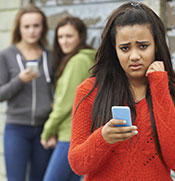
I often overhear school administrators talking about school climate. One of the central areas of concern always revolves around HIB (Harassment, Intimidation, and Bullying). Ever evolving technology such as smartphones and social media facilitate one of the most invasive forms of HIB – cyberbullying.
Cyberbullying is never far fromfrontpage news these days. Recently, a paper presented to the American Sociological Society produced headlines, “Toxic Ties: Networks ofFriendship, Dating, andCyber Victimization.” This headline demonstrates thatcyberbulliesare more often someone close rather than a stranger. Out of a sample of 788 eighth and twelfth-grade students from a New York school, 17% reported being affected by aggressivecyberbullyingin the past week.
As more smart phones find their way into the hands of younger users, cyberbullying is becoming a bigger challenge for schools each year. The impersonal nature of the act of cyberbullying combines with the often close connection between bully and victim to make this particular problem even more difficult to get a handle on.
In an interview with New Haven, Connecticut’s WTNH, Scott Driscoll of Internet Safety Concepts says technology makes it easy for a bully to go beyond the classroom and into a child’s life and sometimes it is even more traumatic.
“When we see cyberbullying it happens outside of the school walls. It happens at 5 o’clock, 6 o’clock at night,” said Driscoll. “The cyberbullying has a different twist to it. It can last for a long time because once people start screen shooting of what they’ve seen online, they share it. They forward it. That can stay online permanently.”
“Child bullying is becoming a problem and, as educators, we really need to see that and be aware of it,” said former principle Kevin McCormick. He says there is no escape from a cyberbully's reach, “There is a lot more in place now especially with bullying on the internet, social media and bullying that you see in school on a regular basis, but at the same time there has to be a real diligence to follow through with it and once in a while some things do slip through the cracks.”
So, what is cyberbullying? Examples of cyberbullying include mean text messages or emails, rumors sent by email or posted on social networking sites, and embarrassing pictures, videos, websites, or fake profiles. It can happen 24/7 and often first affects children when they are alone. Cyberbullies can post their messages anonymously, and these messages often find a wide audience very quickly. It can be very difficult to trace the source of such messages and deleting them is nearly impossible.
The consequences can be dire. In extreme cases, students have been driven to take their own lives rather than live with the social stigma associated with a bullying incident. Kids who are cyberbullied are more likely to use alcohol and drugs, skip school, experience in-person bullying, be unwilling to attend school, do poorly academically, have lower self-esteem, and have more health problems.
As educators, we need to be vigilant and take cyberbullying very seriously. We all know how disruptive electronic devices have become in our classrooms and other school settings. Creating and enforcing rules that limit the use of phones, tablets, and computers to appropriate activities in the school setting can go a long way toward reducing cyberbullying during school hours. Discussing proper digital etiquette and the consequences of cyberbullying in the classroom setting should be a goal for many educators at some point during the school year.
Parents have options, as well. Clearly, it is important to be aware of what your kids are doing online. Communication can be the key. Talk about online risks. Establish clear rules for the use of technology by your children. Model the behavior you want to see – make a point of sharing with your children strategies you use to control your use of social media. Have a discussion with your children about technology rules they have to follow at school. Above all, make sure your children are comfortable with discussing cyberbullying and are willing to confide in you when they are bullied or when they see others being bullied.
Take steps immediately when you discover your child has been affected by cyberbullying. Don’t respond to or forward the messages. Keep evidence of the incident by saving messages and files, and by documenting dates, times and descriptions. Use this evidence to report cyberbullying to web and cell phone service providers. Block the person who is cyberbullying. In addition to your service providers, the incident should be reported to law enforcement and to the school district.
The effects of cyberbullying can be devastating and long-term. It is important that we as educators are vigilant in finding ways to ensure students feel safe, empowered and are able to communicate with us when there is a problem. By committing to this fight against cyberbullying and continuing to send the message that we will support our students, we can help improve our students' self-worth and values within the school community.
Ed
Sources:
https://www.stopbullying.gov/cyberbullying/
http://www.cbsnews.com/news/teen-cyberbullying-more-likely-from-friends-via-social-media-and-texts/
http://www.wsj.com/articles/teens-who-say-no-to-social-media-1472136877
http://counton2.com/2016/08/25/cyber-bullying-goes-beyond-classroom/
http://www.educationnews.org/parenting/closer-social-ties-accompany-cyberbullying-report-says/


